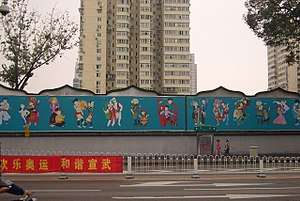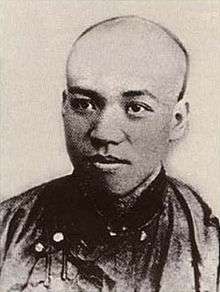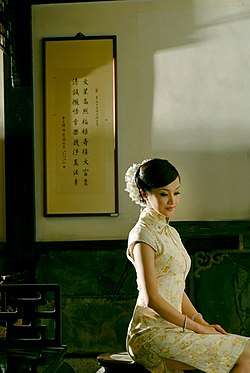Zhonghua minzu
Zhonghua minzu (simplified Chinese: 中华民族; traditional Chinese: 中華民族; pinyin: Zhōnghuá Mínzú; "Chinese nation"[1][2][3]) is a key political term in modern Chinese nationalism related to the concepts of nation-building, ethnicity, and race in the Chinese nationality.[4][5]
.svg.png)

| Zhonghua minzu | |||||||||||||||||||||||||||||||
|---|---|---|---|---|---|---|---|---|---|---|---|---|---|---|---|---|---|---|---|---|---|---|---|---|---|---|---|---|---|---|---|
| Traditional Chinese | 中華民族 | ||||||||||||||||||||||||||||||
| Simplified Chinese | 中华民族 | ||||||||||||||||||||||||||||||
| |||||||||||||||||||||||||||||||
| Part of a series on |
| Names of China |
|---|
Zhonghua minzu was established during the early Republican (1912–1927) and Nationalist (1928–1949) periods to include Han Chinese people and four major non-Han ethnic groups: the Man (Manchus), the Meng (Mongols), the Hui (ethnic groups of Islamic faith in Northwest China), and the Zang (Tibetans),[6][7] under the notion of a republic of five races (Chinese: 五族共和 or Wǔzú gònghé) advocated by Sun Yat Sen and the Chinese Nationalist Party.
Zhonghua minzu was initially rejected in the People's Republic of China (PRC) but resurrected after Mao Zedong's death to include the mainstream Han Chinese and 55 other ethnic groups as a huge Chinese family.[1][4] Since the late 1980s, the most fundamental change of the PRC's nationalities and minorities policies is the renaming from "the Chinese People" (中国人民 or Zhōngguó rénmín) to "the Chinese Nation" (Zhōnghuá mínzú), signalling a shift away from a multi-national communist people's statehood of China to one multi-ethnic Chinese nation state with one single Chinese national identity.[5] With this the Chinese state shifts its claim of representation of people through citizenship, to representing a wider nation with anyone of one of the Chinese ethnicities as nationals, even if they are legaly nationals of other states, such as Taiwan or Singapore.[8] This has caused confusion with calling people Chinese nationals which is the term in international law to refer to the Chinese citizens[8] and not any people who are included in the national identity applied by the Chinese state.
History
An older similar term would be Huaxia, but the immediate roots of the Zhonghua minzu lie in the Qing dynasty founded by the Manchu clan Aisin Gioro in what is today Northeast China. The Qing Emperors sought to portray themselves as ideal Confucian rulers for the Han Chinese, Great Khans for the Mongols, and Chakravartin kings for Tibetan Buddhists.

"Dulimbai Gurun" (Written ᡩᡠᠯᡳᠮᠪᠠᡳ
ᡤᡠᡵᡠᠨ) is the Manchu name for China, has the same meaning with the Chinese name "Zhongguo" (Written 中國, means "Middle Kingdom").[10][11][12] The Qing identified their state as "China" (Zhongguo), and referred to it as "Dulimbai Gurun" in Manchu. The Qing equated the lands of the Qing state, including present day Manchuria, Xinjiang, Mongolia, Tibet and other areas as "China" in both the Chinese and Manchu languages, defining China as a multi ethnic state, rejecting the idea that China only meant Han areas, proclaiming that both Han and non-Han peoples were part of "China", using "China" to refer to the Qing in official documents, international treaties, and foreign affairs, and the "Chinese language" (Dulimbai gurun i bithe) referred to Chinese, Manchu, and Mongol languages, and the term "Chinese people" (中國之人 Zhongguo zhi ren; ᡩᡠᠯᡳᠮᠪᠠᡳ
ᡤᡠᡵᡠᠨ ᡳ
ᠨᡳᠶᠠᠯᠮᠠ Dulimbai gurun-i niyalma) referred to all Han, Manchus, and Mongol subjects of the Qing.[13]
When the Qing conquered Dzungaria in 1759, they proclaimed that the new land was absorbed into "China" (Dulimbai Gurun) in a Manchu language memorial.[14][15][16] The Qing expounded on their ideology that they were bringing together the "outer" non-Han Chinese like the Inner Mongols, Eastern Mongols, Oirat Mongols, and Tibetans together with the "inner" Han Chinese, into "one family" united in the Qing state, showing that the diverse subjects of the Qing were all part of one family, the Qing used the phrase "Zhongwai yijia" (中外一家) or "neiwai yijia" (內外一家, "interior and exterior as one family"), to convey this idea of "unification" of the different peoples.[17] A Manchu language version of a treaty with the Russian Empire concerning criminal jurisdiction over bandits called people from the Qing as "people of the Central Kingdom (Dulimbai Gurun)".[18][19][20][21] In the Manchu official Tulisen's Manchu language account of his meeting with the Torghut Mongol leader Ayuki Khan, it was mentioned that while the Torghuts were unlike the Russians, the "people of the Central Kingdom" (dulimba-i gurun 中國, Zhongguo) were like the Torghut Mongols, and the "people of the Central Kingdom" referred to the Manchus.[22]
Before the rise of nationalism people were generally loyal to the city-state, the feudal fief and its lord or, in the case of China, to the dynastic state.[23] The French Revolution and subsequent developments in Europe paved the way for the modern nation-state and nationalism has become one of the most significant political and social forces in history. Nationalism spread in the early 19th century to central Europe and from there to eastern and southeastern Europe and in the early 20th century nationalism began to appear in China.
While Qing rulers adopted the Han Chinese imperial model and considered their state as Zhongguo ("中國", the term for "China" in modern Chinese), and the name "China" was commonly used in international communications and treaties (such as the Treaty of Nanking),[24] domestically however, some Chinese nationalists such as Sun Yat-sen initially described the Manchus as "foreign invaders" to be expelled,[25] and planned to establish a Han nation-state modelled closely after Germany and Japan. Fearing, however, that this restrictive view of the ethnic nation-state would result in the loss of large parts of imperial territory, Chinese nationalists discarded this concept. The abdication of the Qing emperor inevitably led to controversy about the status of territories in Tibet and Mongolia. While the emperor formally bequeathed all the Qing territories to the new republic, it was the position of Mongols and Tibetans that their allegiance had been to the Qing monarch; with the abdication of the Qing, they owed no allegiance to the new Chinese state. This was rejected by the Republic of China and subsequently the People's Republic of China.

This development in Chinese thinking was mirrored in the expansion of the meaning of the term Zhonghua minzu. Originally coined by the late Qing philologist Liang Qichao, Zhonghua minzu initially referred only to the Han Chinese. It was then expanded to include the Five Races Under One Union, based on the ethnic categories of the Qing.
Sun Yatsen further expanded this concept when he wrote,
有人說,清室推翻以後,民族主義可以不要。這話實在錯了。……現在說五族共和,我們國內何止五族呢?我的意思,應該把我們中國所有各民族融化成一個中華民族。……並且要把中華民族造成很文明的民族,然後民族主義乃為完了。 Some people say, after the overthrow of the Qing, we will have no further need of nationalism. Those words are certainly wrong... At the present we speak of unifying the 'five nationalities' (Han, Manchu, Mongol, Hui, and Tibetan), yet surely our country has far more than five nationalities? My stand is that we should unite all the peoples of China into one Chinese nation (Zhonghua minzu)...and, furthermore, develop that nation into an advanced, civilized nation; only then will nationalism be finished.
The concept of Zhonghua minzu was first publicly espoused by President Yuan Shikai in 1912, shortly after the overthrow of the Qing Dynasty and the founding of the Republic of China. Facing the imminent independence of Outer Mongolia from China, Yuan Shikai stated, "Outer Mongolia is part of Zhonghua minzu [the Chinese nation] and has been of one family for centuries" (外蒙同為中華民族,數百年來儼如一家).
After the founding of the People's Republic of China, the concept of Zhonghua minzu became influenced by Soviet nationalities policy. Officially, the PRC is a unitary state composed of 56 ethnic groups, of which the Han ethnic group is by far the largest. The concept of Zhonghua minzu is seen as an all-encompassing category consisting of people within the borders of the PRC.
This term has continued to be invoked and remains a powerful concept in China into the 21st century. In mainland China, it continues to hold use as the leaders of China need to unify into one political entity a highly diverse set of ethnic and social groups as well as to mobilize the support of overseas Chinese in developing China.
In Taiwan it has been invoked by President Ma as a unifying concept that includes the people of both Taiwan and mainland China without a possible interpretation that Taiwan is part the People's Republic of China, whereas terms such as "Chinese people" can be, given that the PRC is commonly known as "China".[26]
| Part of a series on |
| Nationalism |
|---|
|
Core values |
|
|
Organizations |
|
Related concepts
|
|
Implications
The adoption of the Zhonghua minzu concept may give rise to the reinterpretation of Chinese history. For example, the Manchu-founded Qing Dynasty was originally sometimes characterized as a "conquering regime" or a "non-Han" regime. Following the adoption of the Zhonghua minzu ideology, which regards the Manchus as a member of the Zhonghua minzu, dynasties founded by ethnic minorities are no longer stigmatized.
The concept of Zhonghua minzu nevertheless also leads to the reassessment of the role of many traditional hero figures. Heroes such as Yue Fei and Koxinga, who were originally often considered to have fought for China against barbarian incursions, have been recharacterized by some as minzu yingxiong (ethnic heroes) who fought not against barbarians but against other members of the Zhonghua minzu (the Jurchens and Manchus respectively).[27] At the same time, China exemplified heroes such as Genghis Khan, who became a "national hero" as a member of the Zhonghua minzu.[28]
The Zhonghua Minzu concept in practice gives Chinese nationals who are not of the ethnic Han majority preferential university entry status, favorable tax laws, non-compliance with the one-child policy, among other preferential conditions under Chinese law for ethnic minorities.[29]
Ambiguity
The theory behind the ideology of Zhonghua minzu is that it includes not only the Han but also other minority ethnic groups within China, such as the Mongols, Manchus, Hmong, Tibetans, Tuvans, etc. An ethnic Korean from China living and working in Korea or an ethnic Mongol from China living and working in the Mongolia would both be considered members of the Zhonghua Minzu, which can give rise to potential issues (including contemporary loyalty to contemporary states, the proper boundary lines between states/subnational entities, and the modern categorization of historical states) of identity.
Whether ethnic Han Chinese living overseas and not having Chinese citizenship are considered part of this Chinese nationality depends on the speaker and the context. More often than not, overseas Chinese in Indonesia, Malaysia and Singapore make a clear distinction between being Chinese in a political sense and being Chinese in an ethnic sense, making it unclear whether or not they belong to such a group that contains both political and ethnic connotations.
The conceptual boundaries of the Zhonghua minzu may be complicated by the politics of neighboring countries such as Mongolia and Korea, who exclusively claim regional historical peoples and states. For instance, the idea of Genghis Khan as a "national hero" is contested by Mongolia, which since the fall of socialism has explicitly positioned Genghis Khan as the father of the Mongolian state. In opposition to this, it is common to point out that there are more ethnic Mongolians in China than in the state of Mongolia. In further argument, Mongolians are a large minority in the Russian Federation and some traditionally Mongol lands have never been ruled by Han Chinese.
A dispute of a similar nature has arisen over the status of the state of Goguryeo in ancient history, with China claiming it as Chinese on the grounds that much of it existed within the current borders of China as well as the ancient borders of China. On that basis Chinese nationalists maintain that these territories belong to the heterogeneous origin of the Chinese nation. This view is generally rejected by historians from South Korea and North Korea, as well as experts on Goguryeo history from various countries such as the United States, Russia, Mongolia, and Australia.[30][31][32] It has also received criticism from certain domestic scholars, such as Song Chengyou, professor of history at Peking University, who likewise considered Goguryeo as a part of Korean history and denied Chinese connections.[33]
See also
References
Citations
- Dan Landis; Rosita D. Albert (14 February 2012). Handbook of Ethnic Conflict: International Perspectives. Springer. pp. 182–. ISBN 978-1461404477.
- Zhao, Suisheng (2000). "Chinese Nationalism and Its International Orientations". Political Science Quarterly. 115 (1): 1–33. doi:10.2307/2658031. JSTOR 2658031.
- Zhou Wenjiu, Zhang Jingpeng (2007). "关于"中华民族是一个"学术论辩的考察" [On the academic argument that "the Chinese nation is one"]. Minzu Yanjiu. 3: 20–29 – via http://d.old.wanfangdata.com.cn/Periodical/mzyj200703003.
- Alan Lawrance (2004). China Since 1919: Revolution and Reform: a Sourcebook. Psychology Press. pp. 252–. ISBN 978-0-415-25141-9.
- Donald Bloxham; A. Dirk Moses (15 April 2010). The Oxford Handbook of Genocide Studies. Oxford University Press. pp. 150–. ISBN 978-0-19-161361-6.
- Fitzgerald, John (January 1995). "The Nationaless State: The Search for a Nation in Modern Chinese Nationalism". The Australian Journal of Chinese Affairs. 33 (33): 75–104. doi:10.2307/2950089. ISSN 0156-7365. JSTOR 2950089.
- Susan Debra Blum; Lionel M. Jensen (2002). China Off Center: Mapping the Margins of the Middle Kingdom. University of Hawaii Press. pp. 170–. ISBN 978-0-8248-2577-5.
- Sense Hofstede (1 October 2017). "Never Forget Chinese Nationalism's Ethnocentrism". SenseHofstede.nl. Retrieved 17 July 2020.
- Chagatai is the predecessor of Uyghur
- Hauer 2007, p. 117.
- Dvořák 1895, p. 80.
- Wu 1995, p. 102.
- Zhao 2006, pp. 4, 7, 8, 9, 10, 12, 13, 14.
- Dunnell 2004, p. 77.
- Dunnell 2004, p. 83.
- Elliott 2001, p. 503.
- Dunnell 2004, pp. 76–77.
- Cassel 2011, p. 205.
- Cassel 2012, p. 205.
- Cassel 2011, p. 44.
- Cassel 2012, p. 44.
- Perdue 2009, p. 218.
- nationalism;Identification of state and people
- Empire to nation: historical perspectives on the making of the modern world, by Joseph Esherick, Hasan Kayalı, Eric Van Young, p. 232
- French Centre for Research on Contemporary China (CEFC). (cf. by Tongmenghui adherent)
- See, e.g. Ma Ying-jeou, President of Republic of China inauguration speech, 20 May 2008: (Section 2, Paragraph 8)
- What makes a national hero?
- The Chinese Cult of Chinggis Khan: Genealogical Nationalism and Problems of National and Cultural Integrity, City University of New York.
- Ethnic Mosaic of Modern China: An Analysis of Fertility and Mortality Data for the Twelve Largest Ethnic Minorities.
- Bae, Young-dae; Min-a Lee (16 September 2004). "Korea finds some allies in Goguryeo history spat". Joongang Ilbo. Retrieved 6 March 2007.
- Byington, Mark (1 January 2004). "Koguryo part of China?". Koreanstudies mailing list. Retrieved 6 March 2007.
- "Korean-Russian academia jointly respond to Northeast Project" (in Korean). Naver. 31 October 2006. Retrieved 6 March 2007.
- "Chinese Scholar Slams Co-opting Korean History". Chosun Ilbo. 13 September 2006. Archived from the original on 19 October 2006. Retrieved 6 March 2007.
Sources
- Cassel, Par Kristoffer (2011). Grounds of Judgment: Extraterritoriality and Imperial Power in Nineteenth-Century China and Japan. Oxford University Press. ISBN 978-0199792122. Retrieved 10 March 2014.
- Cassel, Par Kristoffer (2012). Grounds of Judgment: Extraterritoriality and Imperial Power in Nineteenth-Century China and Japan (illustrated ed.). Oxford University Press. ISBN 978-0199792054. Retrieved 10 March 2014.
- Dvořák, Rudolf (1895). Chinas religionen ... Volume 12; Volume 15 of Darstellungen aus dem Gebiete der nichtchristlichen Religionsgeschichte (illustrated ed.). Aschendorff (Druck und Verlag der Aschendorffschen Buchhandlung). ISBN 978-0199792054. Retrieved 10 March 2014.
- Dunnell, Ruth W.; Elliott, Mark C.; Foret, Philippe; Millward, James A (2004). New Qing Imperial History: The Making of Inner Asian Empire at Qing Chengde. Routledge. ISBN 978-1134362226. Retrieved 10 March 2014.
- Elliott, Mark C. (2001). The Manchu Way: The Eight Banners and Ethnic Identity in Late Imperial China (illustrated, reprint ed.). Stanford University Press. ISBN 978-0804746847. Retrieved 10 March 2014.
- Hauer, Erich (2007). Corff, Oliver (ed.). Handwörterbuch der Mandschusprache. Volume 12; Volume 15 of Darstellungen aus dem Gebiete der nichtchristlichen Religionsgeschichte (illustrated ed.). Otto Harrassowitz Verlag. ISBN 978-3447055284. Retrieved 10 March 2014.
- Perdue, Peter C. (2009). China Marches West: The Qing Conquest of Central Eurasia (reprint ed.). Harvard University Press. ISBN 978-0674042025. Retrieved 10 March 2014.
- Wu, Shuhui (1995). Die Eroberung von Qinghai unter Berücksichtigung von Tibet und Khams 1717–1727: anhand der Throneingaben des Grossfeldherrn Nian Gengyao. Volume 2 of Tunguso Sibirica (reprint ed.). Otto Harrassowitz Verlag. ISBN 978-3447037563. Retrieved 10 March 2014.
- Zhao, Gang (January 2006). "Reinventing China Imperial Qing Ideology and the Rise of Modern Chinese National Identity in the Early Twentieth Century". Modern China. Sage Publications. 32 (1): 3–30. doi:10.1177/0097700405282349. JSTOR 20062627.
External links
- The War of Words Between South Korea and China Over An Ancient Kingdom: Why Both Sides Are Misguided Zhonghua minzu and the Sino-Korean controversy over the 'ownership' of ancient Koguryo.
- Sinicization vs. Manchuness: The Success of Manchu Rule

